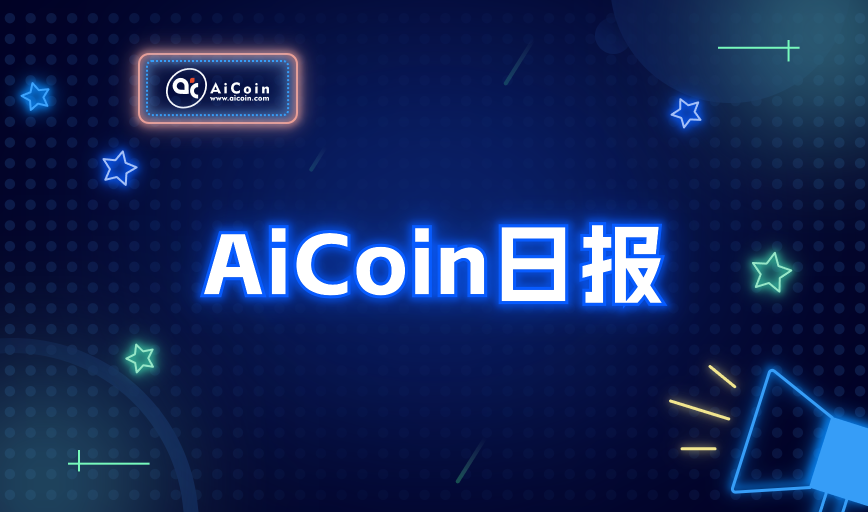Original Text: "ZetaChain: The Path Forward for Universal Apps"
Author: Delphi Consulting
Translation: Odaily Planet Daily, Fu Ruhao
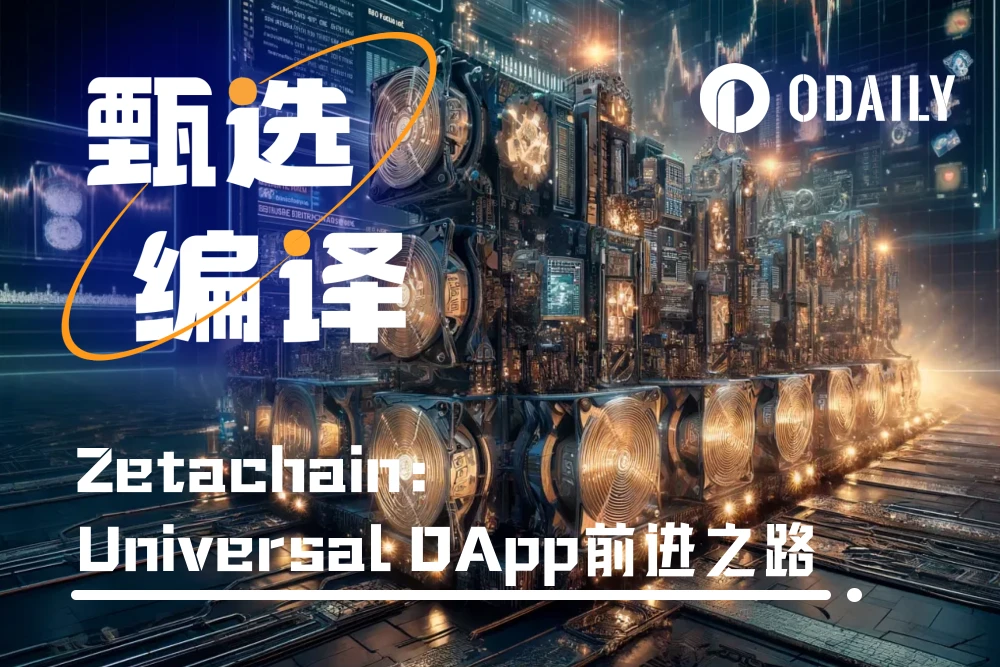
Due to the large number of words and the overly technical content, Odaily Planet Daily has distilled the core points of the article to facilitate readers' quick understanding of the latest developments of ZetaChain.
In order to create a more user-friendly underlying foundation, ZetaChain brings chain abstraction into Web3 and proposes numerous solutions. The specific key points are as follows:
ZetaChain is an L1 blockchain based on Cosmos SDK, designed for universal smart contracts and unified application experience. It achieves chain abstraction through the following layers of architecture:
Permission layer: Handles accounts and permissions, simplifying user interaction with smart contract wallets and proxy services.
Solver layer: Provides the optimal transaction path, automating the decision-making process to reduce user cognitive burden.
Settlement layer: Utilizes cross-chain solutions such as bridges and oracles to ensure efficient transaction completion.
Main features of ZetaChain
Universal EVM: Improved Ethereum Virtual Machine supporting universal applications.
Cross-chain message passing: Allows developers to build universal applications that can call connected chains.
ZRC 20 standard: Supports universal homogeneous tokens, simplifying cross-chain asset management.
TSS signers: Verify the security of cross-chain transactions.
Enhanced features of ZetaChain 2.0
Universal DApp: Supports calling contracts on connected chains from Universal DApps, enabling complex cross-chain interactions.
Universal accounts: Simplifies the process of managing assets across multiple blockchains.
Expanded Bitcoin address compatibility: Supports more types of Bitcoin addresses.
Added chain support: Expands network coverage by adding new chains through governance processes.
Use cases
Native exchange: Enables cross-chain asset exchange, allowing users to complete complex cross-chain transactions with just one interaction.
Staking: Smart contract staking of ZETA tokens simplifies liquidity and re-staking application development.
NFT applications: Supports cross-chain NFT minting and transfer.
Additionally, ZetaChain compares with other related solutions, and readers are encouraged to delve deeper into this part to better understand the strengths and weaknesses of different solutions. The author will not elaborate further here. In summary, ZetaChain simplifies the Web3 user experience and makes it more akin to the intuitive operation of Web2 through automated and optimized cross-chain interactions.
Introduction to Chain Abstraction
One of the main differences between Web3 and Web2 applications is their usability. In Web2, users are often unaware of the complexity happening behind the scenes. For example, when sending an email through Gmail, users only need to input and click "send." The system then handles server communication, data encryption, and spam filtering without any user intervention. Similarly, ordering food on UberEats involves seamless integration of restaurant menus, payment gateways, and delivery tracking. The same applies to payment systems, messaging services, and more. All this underlying complex technology is abstracted from the user.
In fact, these applications further enhance themselves by adding automated processes on top. Netflix not only abstracts the underlying technology but also intentionally starts the next episode without the viewer pressing a button. The business of these applications is to prolong the time spent as much as possible, and a clunky interface is akin to handing market share directly to competitors.
Web3 applications may not be more complex than Web2 applications that already serve billions of consumers. However, they do feel designed for people with an IQ higher than Gary Kasparov. For the average user, the number of options and steps involved in using Web3 is very complex. Users face a multitude of chains, bridges, and other connecting infrastructure. Managing multiple wallets and safeguarding mnemonic phrases adds to the complexity. If we want to build a platform that powers the next generation of consumer applications, all of this needs to change.
Chain Abstraction
The attention to account abstraction is well-founded. It is an important step forward in simplifying Web3 UX. Features such as universal keys, account recovery, and gas extraction are valuable improvements. However, they only address a small part of the overall user experience challenge.
The obstacle lies in the multitude of Rollup choices, L1s, bridges, and DApps, which go beyond account-related issues. This fragmentation creates a complex and confusing situation for users. Chain abstraction addresses these issues by extending the solvable UX problems to their maximum range. The idea is to envision an ideal user interaction state where, similar to the Web2 experience, users do not need to understand what a blockchain or bridge is.
Ideally, using Web3 applications should be as intuitive as sending an email or ordering food online. Users should not need to know which blockchain their transactions are on, how to choose the right bridge, or how to manage multiple wallets and mnemonic phrases. Instead, all this complexity should be seamlessly handled in the background. This way, users can focus on their intended activities without the burden of underlying technical details.
To address this issue, many efforts are currently being made. The CAKE framework, Near Protocol, and Particle Network address these issues by breaking them down into specific layers for each problem. Few projects vertically integrate across all layers, while others focus on individual layers. Broadly, there are account aggregation issues, routing issues, solving issues, and bridge selection issues.
The Frontier team has proposed a three-layer stack through their CAKE framework to systematically address these problems.
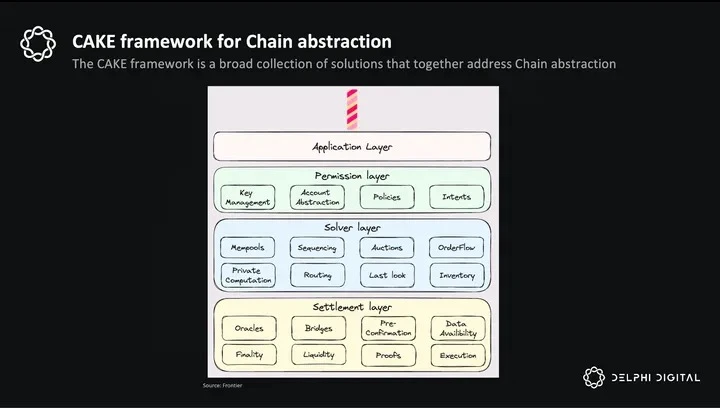
Permission layer: This layer handles accounts and permissions. It includes smart contract wallets and proxy services designed to abstract user interaction while balancing usability and user control.
Solver layer: The second layer focuses on the Solver market and competition among them. This layer finds the best solution for users based on their preferences for speed, cost, and efficiency, addressing routing issues. Solver markets compete to provide the best transaction path, enhancing the overall user experience through automated decision-making processes and reducing user cognitive burden.
Settlement layer: The final layer is responsible for settling interactions. It leverages bridges, oracles, and other cross-chain solutions to ensure efficient and accurate transaction completion. This layer abstracts the complexity of cross-chain interactions.
We will later compare different solutions within these layers. ZetaChain is one of the solutions addressing multiple problems.
At a high level, ZetaChain is an L1 blockchain based on Cosmos SDK, using CometBFT as the consensus protocol. Its core value proposition is to deploy universal smart contracts and provide a unified application experience. Developers only need to deploy a contract, and ZetaChain will handle cross-chain interactions. In the following sections, we will first explore how ZetaChain operates and understand its mechanisms. Later, we will discuss the enhanced features in version 2.0, focusing on new functionalities and improvements.
ZetaChain Architecture

ZetaChain components and their functionalities:
Universal EVM: An improved Ethereum Virtual Machine (EVM) designed for building universal applications.
Communication mechanisms:
Universal: An interoperability layer allowing developers to build universal applications that can call from connected chains.
Connector API: Peer-to-peer cross-chain messaging supporting arbitrary data and value transfer.
ZRC 20: Standard for universal homogeneous tokens. Native gas and supported ERC 20 tokens can be sent as ZRC 20 from connected chains to universal applications. ZRC 20 tokens can be withdrawn to connected chains.
TSS signers: Validators with additional responsibilities, including signing and monitoring outbound transactions.
TSS Addresses: Specific addresses for depositing tokens and initiating cross-chain interactions.
ZetaChain, like Near Protocol and Lit, uses Threshold Signatures. Threshold Signature Scheme (TSS) is a cryptographic method where signatures are collaboratively generated by a group of participants. It requires a minimum threshold number of participants (e.g., 3 out of 5) to produce a valid signature, with each participant holding a share of the private key. This enhances security by distributing private keys among multiple parties, preventing single points of failure, and ensuring fault tolerance.
On ZetaChain, observer-signer validators run two different software:
ZetaChain nodes: Blockchain nodes handling cross-chain transactions, ZRC 20 minting management, and universal application calls.
ZetaClient: Off-chain program run by observer-signers to observe transactions on connected chains and sign and broadcast transactions on behalf of ZetaChain on connected chains.
These TSS signers continuously monitor deposit addresses on all supported chains to ensure they pass information upon successful transactions, triggering activity on ZetaChain. Additionally, they are responsible for signing outbound transactions and dispatching them to other chains for processing.
This allows contracts deployed on the Universal EVM to not be limited to ZetaChain. They can be called from connected chains.
Inbound Communication:
Users can interact with DApps built on ZetaChain from any external chain. TSS observers monitor specific deposit addresses for native gas tokens and ERC 20 assets in ERC 20 custodial contracts. Transactions or ERC 20 custodial contracts created to this deposit address embed function call information. TSS observers verify this content and send it to the system contract, which calls the OnCrossChainCall function in the corresponding contract to execute it.
Outbound Communication:
Contracts on ZetaChain can call connected chains using the Connector API. The contract calls the Connector contract, containing details such as chain ID, contract address, and message. ZetaChain then processes this call and forwards the details to the target chain, where the receiver contract's "onZetaMessage" function is called.
These mechanisms ensure that ZetaChain contracts can effectively respond to and initiate requests from other chains, with minimal effort required from DApp developers or users.
Inbound and outbound communication between ZetaChain and external chains is triggered by users from their front end. This means they can interact with a simple front end without needing to understand the underlying mechanisms.
After understanding the basic ZetaChain architecture, let's shift our focus to the latest iteration - ZetaChain 2.0 and its enhanced functionalities.
ZetaChain 2.0
ZetaChain 2.0 has now been upgraded, incorporating new added functionalities to make the previous experience more comprehensive. It supports broader compatibility with Bitcoin addresses, replaces the Connector API with expanded universal functionalities, and offers a simpler user experience with universal accounts.
The new feature of directly calling contracts on connected chains from Universal applications enables powerful universal applications. Applications can now handle various assets and interactions across multiple chains in a single user step. For example, a user on Bitcoin can trigger a ZetaChain contract, which seamlessly executes additional contracts on Ethereum, BNB, and other chains.
Universal Applications

One of the biggest new additions in ZetaChain 2.0 is the Universal DApp. ZetaChain 1.0 provided two separate functionalities: cross-chain message passing and universal applications. By using the Connector API for cross-chain message passing, users could use ZetaChain as a relay to send arbitrary messages between connected chains. The universal functionality allowed Universal DApps to accept calls from connected chains and manage homogeneous tokens on connected chains.
In ZetaChain 2.0, the Connector API is being replaced by expanded universal functionalities, allowing Universal DApps to call contracts on connected chains. For example, a user can stake BTC, send LST to BNB, exchange LST, and then borrow on Polygon, all in a single interaction. This transforms applications from universal to a Universal DApp with multi-legged flows.
In terms of mechanism changes, the gateway shifts communication to a hub-and-spoke model, reducing costs and execution steps. The earlier Connector API method was more like point-to-point communication and introduced more steps and costs. The gateway acts as the user's entry point and simplifies interactions.
These are some detailed insights:
Expanded Universal Chain Functionality: ZetaChain 2.0 allows Universal DApps to withdraw ZRC 20 tokens and call contracts on connected chains through the withdrawAndCall function. Universal DApps can also make contract calls on connected chains without withdrawing tokens.
Disabling Connector API: ZetaChain 2.0 does not provide separate APIs for universal and cross-chain message passing, instead offering a consistent and unified API for building Universal DApps.
Gateway Contracts: ZetaChain 2.0 introduces gateway contracts, serving as single entry points on connected chains for developers to interact with Universal DApps. Developers no longer send native gas assets to TSS addresses or ERC 20 to custodial contracts, but have a gateway contract to interact with.
Allowing Staking of ZETA Tokens from Contracts: ZetaChain 2.0 introduces the ability for smart contracts to stake native ZETA tokens on-chain. This makes it easier for developers to build Universal DApps that can stake ZETA in a decentralized manner without relying on off-chain programs.
Modular Code Structure: Earlier versions bundled state transition and message passing logic, making the code complex. The new version separates state transition and message passing logic, simplifying the codebase and improving its manageability and maintainability.
Universal Accounts
Universal Accounts simplify the way users manage assets across multiple blockchains. The withdrawAndCall function introduced in ZetaChain 2.0 allows users to withdraw assets and call smart contracts across chains in a single transaction. This function first ensures the necessary gas fees, then burns the specified tokens from the user's account, and finally executes further operations on the target chain.
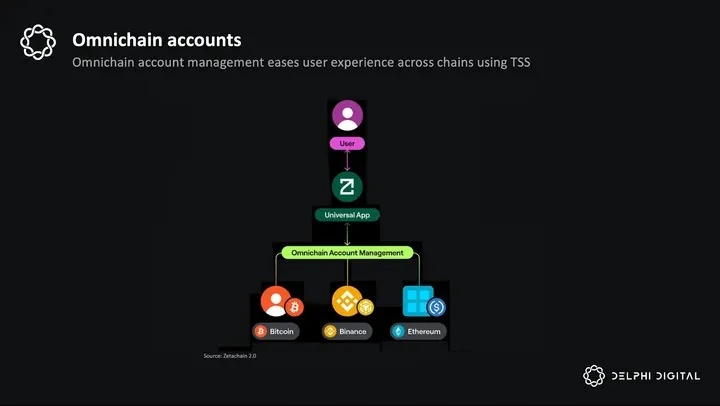
The withdrawAndCall function on ZetaChain simplifies transactions by combining multiple steps into one. It calculates and transfers the gas fees required for ZetaChain and the target chain. It then securely burns the specified amount of tokens from the user's account. An event called WithdrawalAndCall is emitted, recording the withdrawal and providing the data needed to call smart contracts on the target chain. Finally, the specified operation is executed on the target chain.
This reduces the need for multiple steps and network switches, making cross-chain operations simpler. For example, users using a yield aggregator on ZetaChain can withdraw tokens, send them to another chain, and execute investment commands on a smart contract on that chain - all in a single transaction.
Enhanced BTC Experience
ZetaChain 1.0 only supported transactions using specific addresses, limiting interactions. In ZetaChain 2.0, they have expanded their compatibility, including a wider range of Bitcoin address types - P2PKH, P2SH, P2WSH, and P2TR. This makes it accessible and user-friendly for all transaction types. Additionally, with the inclusion of Taproot (P2TR) and continued support for SegWit-based addresses (P2WPKH and P2WSH), users can now enjoy benefits such as improved privacy, reduced transaction fees, and increased transaction efficiency.
Transaction Types in BTC
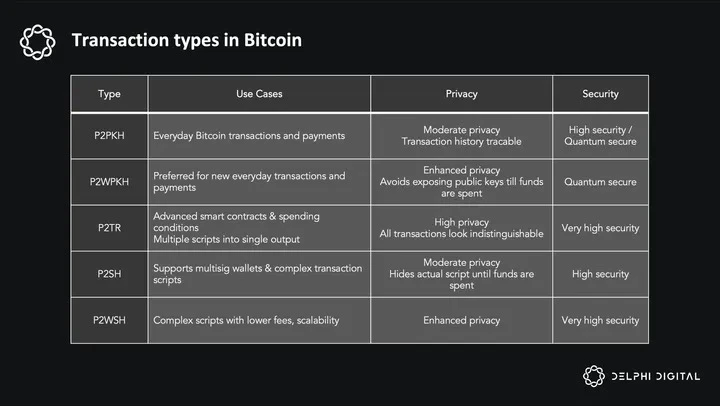
This is achieved through updates in three areas:
- Address Handling
Enhanced Decoding: ZetaChain 2.0 has custom decoding functions to identify and handle different formats of Bitcoin addresses, such as P2PKH, P2SH, P2WSH, and P2TR. These decoding functions are crucial for identifying each address type, extracting key components (such as public key hash or script hash), and performing thorough verification to ensure accuracy and security.
Support for Taproot (P2TR): Taproot supports multisignature, complex spending conditions, and enhanced privacy. This address type uses unique features such as Schnorr signatures and advanced scripts, which differ from the processing capabilities initially equipped in ZetaChain. To extend support for Taproot, ZetaChain has created a new address type, AddressTaproot. This new design aims to integrate with existing infrastructure by following the same structure and standards, ensuring compatibility with existing systems.
- Transaction Creation
- ZetaChain 2.0 now includes specific scripts for each Bitcoin address type to ensure transactions comply with the unique requirements of P2PKH, P2SH, P2WSH, and P2TR addresses. These scripts are crucial for defining how transactions are processed, especially addressing the special requirements for witness data in SegWit-based addresses (such as P2WSH and P2TR).
Transaction Parsing
Improved parsing logic that can uniformly handle the unique characteristics of P2PKH, P2SH, P2WSH, and P2TR address types. This means the system can correctly identify, extract, and verify the necessary components for each address type.
Additional Chain Support
ZetaChain adds new chains to its network through careful governance processes and software updates. This ensures smooth integration of each new chain. Currently, they are considering adding Polygon, Base, Solana, and IBC chains.
Adding new chains may be easier or more challenging depending on their signature schemes. EVM chains like Ethereum are easier to add due to widespread support for their signature schemes. Other chains may be more challenging. For example, newer chains like Solana, NEAR, and TON typically use EdDSA (Ed25519 curve) instead of ECDSA (secp256k1 curve). This can pose challenges for the TSS module, as ECDSA TSS in GG18 and GG20 is more mature and has undergone more real-world testing than EdDSA TSS. Fortunately, these new chains often have smart contract capabilities and typically effectively support secp256k1 operations at the smart contract level. This allows ZetaChain to use relatively mature ECDSA TSS technology to connect to these chains.
Additionally, observer validators in the ZetaChain network need to run nodes for all supported chains. This enables them to verify transactions on different chains.
ZetaChain currently communicates with other chains through its cross-chain messaging protocol and ZetaClient TSS. There are also proposals to integrate IBC modules to enhance these communications and expand the coverage of universal contracts to application chains in the Cosmos ecosystem.
Other Updates
RPC: ZetaChain is forking the current Ethermint module to expand it and address these issues. Ethermint has been updated to the latest version to support the latest features and security. Additionally, they are researching other issues related to JSON RPC. Customizing the Ethermint EVM module and improving RPC compatibility ensures better handling of cross-chain transactions and zEVM contract interactions.
Throttle Mechanism: In order to protect the network from unwanted or malicious activities, ZetaChain has implemented an adjustable throttle mechanism. The system dynamically adjusts transaction rates based on current network conditions and predefined rules. By managing transaction flow, this mechanism enhances network stability and security, preventing potential threats such as spam transactions or flash loan attacks. This new feature not only prevents network abuse but also ensures continuous reliability and security for all users.
General Applications on ZetaChain
In ZetaChain 2.0, contracts can be called from external chains and contracts on external chains can also be invoked. Applications developed using it typically operate in a similar general manner in the background. The first part of the application involves constructing a transaction, with detailed function call information sent to the universal contract. This is done by the DApp frontend. It is sent by TSS observers and forwarded to the corresponding contract on ZetaChain. These are then passed to the systemContract, which acts as a gatekeeper. The contract ensures that only authorized functions (such as OnCrossChainCall) can trigger the subsequent steps of the process, adding an additional layer of security. The OnCrossChainCall function in the target contract processes the incoming message to identify and execute the required function.
Once this operation is successfully executed, the result is processed and sent to the target chain. The final result is received directly in the user's wallet on the target chain. From the user's perspective, this interaction involves simply initiating a transaction on the source chain and receiving the result on the target chain. ZetaChain handles all the complex details of transaction construction, verification, and execution behind the scenes, making cross-chain interactions appear effortless. Users experience a smooth and direct process, only seeing the transactions they sign and the final results, with all intermediary steps effectively managed by ZetaChain's infrastructure.
Specific Applications
Native Swaps
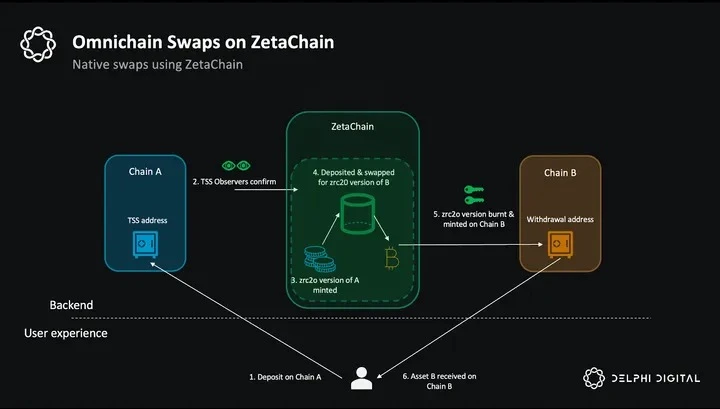
Using ZetaChain, cross-chain swap applications can be implemented as Universal contracts. Users first send native gas or supported ERC 20 assets to the gateway contract on the connected chain, along with the Universal contract address and a message (containing the target token and recipient). Observer-signer validators observe and process the transaction. The homogenization module mints ZRC 20 tokens representing the tokens deposited into the Gateway contract, and the system contract calls the onCrossChainCall function of the Universal contract. This function accepts ZRC 20 tokens, context (including the ID of the connected chain and the caller's address), and a message. The Universal contract then uses one of the available liquidity pools (defaulting to the Uniswap v2 pool or any other DEX contract) to exchange the incoming ZRC 20 tokens for ZRC 20 tokens of the target token and ZRC 20 tokens of the gas token on the target chain. Finally, the contract calls the ZRC 20 withdrawal method to withdraw the ZRC 20 gas tokens (used to pay for the gas cost on the target chain) and withdraw the target ZRC 20 tokens as native assets to the target chain.
Staking
The ability for smart contracts to stake ZETA simplifies the development of liquidity staking and restaking applications on ZetaChain.
In the past, staking applications required off-chain programs to monitor deposits of ZETA into smart contracts and stake ZETA on behalf of users. This off-chain mechanism was a centralized source, making it more difficult to build flexible and decentralized staking protocols.
With the ability to stake ZETA, contracts can natively accept ZETA tokens from users and other contracts, stake ZETA using the chain's native staking mechanism (Cosmos SDK staking module), query the staking module, and claim rewards.
Utilizing this feature, Universal DApps can accept tokens from connected chains, provide ZETA tokens and stake on behalf of users, and earn rewards on tokens transferred on the connected chain.
NFT Applications
The ability for Universal DApps on ZetaChain to natively call smart contracts on connected chains enables the creation of innovative NFT applications. Developers can create applications that accept tokens and messages from connected chains, mint NFTs, and allow users to transfer these NFTs from ZetaChain to connected chains and back.
New Applications Enabled by ZetaChain
ZetaChain's universal infrastructure enables DeFi applications to operate across multiple chains, rather than being limited to a single chain. One of the main advantages of Web3 is its composability, allowing smart contracts to interact and build with each other. Currently, this interaction is limited to contracts on the same chain. However, ZetaChain extends this composability to all chains, including those without native smart contract support, such as Bitcoin and Dogecoin. This broadens the range of use cases from which developers can benefit from chain abstraction, laying the foundation for DApp-level innovation.
Universal Fund Management
Managing funds across multiple blockchains is a complex task. When an organization's assets are distributed across different chains, each with its own native accounts, the management process becomes challenging and mishandling can lead to asset loss. Without a unified solution, fund managers must deal with multiple accounts, coordinate signatures from stakeholders on various chains, and manually track assets on different networks. This decentralized approach not only increases operational risks but also limits the financial department's ability to effectively manage and deploy assets.
By using ZetaChain's infrastructure, organizations can centrally control their funds while maintaining the decentralized nature of blockchain assets. The key innovation lies in the use of programmable TSS and smart contracts.
Fund managers can write their management logic in a single smart contract deployed on ZetaChain. The contract serves as the central control point for all financial operations across multiple chains. The initial setup requires stakeholders to provide their keys only once on ZetaChain, greatly simplifying the approval process.
Once set up, the ZetaChain smart contract can coordinate complex fund operations across different blockchains. This means that assets can be moved, allocated, or utilized across various chains through a single approval process on ZetaChain, without the need for multiple signature iterations from all stakeholders on native chains.
This approach is not limited to fund transfers. Fund policies, spending limits, and approval thresholds can be directly programmed into the smart contract for consistent application across all chains. Additionally, it opens up possibilities for more complex fund management strategies, such as automatic cross-chain rebalancing or yield optimization, which were previously impractical due to the complexity of managing multiple independent blockchain accounts.
Universal Portfolio Management
Managing a cryptocurrency investment portfolio across multiple chains is extremely challenging, as users struggle to balance assets and track performance on different networks. ZetaChain simplifies this process through a unified universal portfolio management platform.
Universal smart contracts act as a central control tower for all user crypto assets, which is key to the solution. The contract interacts directly with accounts on various chains using TSS. Users can encode investment strategies and rules in the ZetaChain smart contract. The contract then uses TSS to execute trades, move assets, and rebalance the investment portfolio across different blockchains without manual intervention.
The smart contract can monitor market conditions, automatically rebalance the investment portfolio, and execute complex cross-chain transactions without human intervention. It does this by generating signatures through TSS, allowing it to securely control assets across multiple chains.
This approach not only automates cross-chain operations but also provides a comprehensive view of the entire portfolio's performance. It opens up possibilities for complex investment strategies such as cross-chain arbitrage or multi-chain yield farming, which were previously impractical.
This is crucial for attracting and expanding the user base, as these users are interested in income opportunities but may not be familiar with the specific steps required on each chain. By abstracting the complexity of multi-chain operations, ZetaChain enables a wider range of users to use advanced cryptocurrency portfolio management.
Native Swapping
We have already discussed native asset swapping applications similar to ThorChain, where users can deposit and receive assets in their native form. From the user's perspective, this process is as simple as depositing and receiving funds on a centralized exchange. Due to the input and output being simple transfers on the connected chain, this has significant cost advantages compared to message-based methods, where the involved contract calls (message verification, etc.) can be very expensive. All logic is in one place in the universal contract, rather than being executed individually on the involved chains.
Cross-Chain Lending
ZetaChain 2.0 enhances cross-chain lending by enabling direct function calls from ZetaChain to external chains. This allows the deployment of cross-chain lending protocols on ZetaChain, accepting deposits from lenders on any chain without requiring additional effort from users. Deposits can include assets from liquidity pools, liquidity staked assets, and more from any supported chain. On the borrower side, collateral can be provided in various asset types across multiple chains, creating a flexible lending ecosystem. For example, the BTC native lending market doesn't have many options. This opens up new opportunities and markets for builders to earn from BTC and borrow against other assets. Compared to ThorChain, development on ZetaChain also provides more options, allowing for different architectures to be built with the same input and output tokens.
Re-staking Assets from Any Chain
Assets from supported chains can be used to provide re-stakable security for other chains, similar to the Eigenlayer approach. Resakers can use assets such as BTC, ETH, which may be significantly reduced based on specific conditions of the target chain or application. This pooled security model allows chains or applications to leverage a diversified pool of idle assets, enhancing overall security and providing stronger protection for the entire ecosystem.
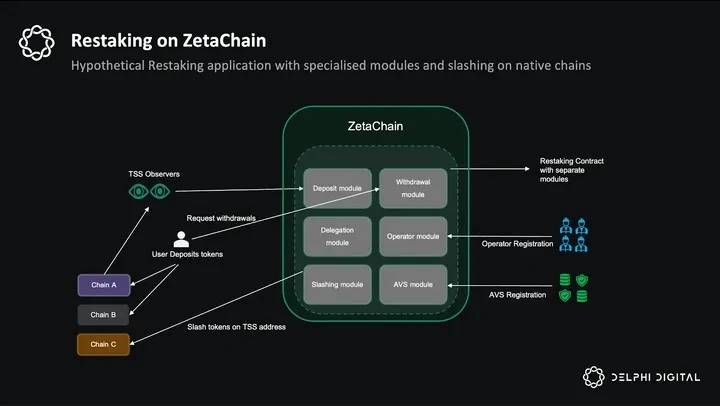
This application may be similar to Exocore, where smart contracts on ZetaChain coordinate key functions. These contracts act as modules, managing different aspects such as AVS registration, tracking equity delegation, handling deposits, processing withdrawals, and executing reductions.
When users interact with the system—whether by staking tokens or delegating their assets to others—these transactions are recorded by the corresponding smart contracts. This ensures that all user activities are recorded and managed within the ZetaChain ecosystem.
TSS signers actively monitor validators to ensure their loyalty. If validators are malicious or users initiate withdrawals, the reduction module responds by reducing the stake on the native chain.
Multi-Chain Settlement
Assuming a user wants to borrow against assets from different chains, it is difficult for users and applications to monitor and manage the settlement of these assets. It requires continuous cross-chain monitoring and rapid execution to minimize losses to the protocol. With ZetaChain, assets can be locked in TSS addresses and settled using AMM/DEX on the source chain, with significantly more liquidity on the source chain compared to wrapped versions on other chains. This minimizes the time spent on settlement and bridging and takes advantage of better rates due to higher native liquidity. TSS observers continuously monitor these positions, and Universal DApps on ZetaChain track them. Once the price of the assets reaches the required settlement level, the smart contract triggers it, is forwarded by TSS signers, and settled on the native chain.
BTC Applications
Markets like Ordinals, BRC20, and applications for swapping and lending BTC assets are all implemented using ZetaChain. These applications can not only integrate with other applications on ZetaChain but also with applications on other supported chains. All applications supported by the standard smart contract chain and ZetaChain's full-chain functionality for Bitcoin and other assets are supported.
Lending between BTC and ETH assets will use TSS addresses. This application can be deployed as a Universal DApp on ZetaChain and have its underlying logic. If a user wants to borrow ETH using their BTC, they simply deposit BTC on the native chain and sign with their wallet. The BTC is locked in a TSS address, awaiting withdrawal or settlement. TSS observers record this, and ZRC 20 versions of ETH are minted on ZetaChain and sent and exchanged for ETH directly into the user's account on Ethereum. The user simply deposits with their wallet and receives ETH in their ETH wallet. As simple as a centralized exchange. Other applications, such as Ordinals markets, have similar simplicity in swaps.
Cross-Chain Orchestration
Chain abstraction is addressing a wide range of issues in areas such as account aggregation, resolution, orchestration, settlement, and clearing. We will explore several approaches to solving orchestration problems and compare them with ZetaChain.
Agoric
Agoric is a JavaScript-based smart contract platform built using Cosmos SDK and CometBFT. It communicates with other Cosmos chains using IBC and Axelar. Agoric aims to onboard millions of JavaScript developers into Web3. The Agoric Orchestration API abstracts the complexity of orchestrating contracts across different chains, simplifying the development process.
One of Agoric's standout features is its unique async/await model. This model allows smart contracts deployed on Agoric to interact with other chains, await responses, and execute workflows across multiple blocks. When Agoric sends messages to other chains, these messages contain instructions (such as account creation or function calls) and necessary parameters. Once the target chain processes these instructions and returns the result, the Agoric smart contract continues to execute the subsequent steps defined in its logic.
Everclear (formerly Connext)
Everclear, formerly known as Connext, has a bridge that facilitates cross-chain workflows and re-staking from multiple L2s. By integrating the Connext SDK, xApps can send special messages called xcalls across chains. These messages are managed by Connext contracts on the source and target chains, in addition to adapter contracts, to achieve cross-chain function calls.
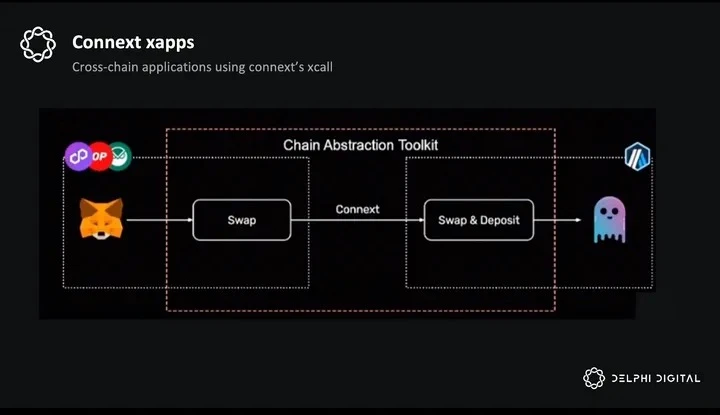
Using the Connext SDK, xApps can compile and send xcall messages loaded with all necessary execution details, such as function calls, funds, gas information, and other data. These messages are initially processed by Connext contracts on the source chain, and then the Connext contracts forward them to the corresponding entities on the target chain. Here, the adapter contract plays a crucial role by receiving these messages, converting assets when necessary, and executing the specified function with the correct parameters. Connext's system supports nested xCalls, mimicking callbacks between chains to verify state changes and execute asynchronous follow-up operations.
This enables Connext to effectively act as a bridge, executing contract functions on various chains and supporting complex cross-chain workflows. This is somewhat similar to ZetaChain, where function calls are relayed to the target chain and executed.
Comparison between xERC 20 and ZRC 20 Tokens
Both ZetaChain and Connext have developed token standards—ZRC 20 and xERC 20, respectively—to facilitate cross-chain applications.
ZRC 20 tokens are adaptations of the ERC 20 standard on Ethereum, designed specifically for cross-chain functionality on ZetaChain. ZRC 20 tokens are only minted on ZetaChain after the corresponding ERC 20 tokens are deposited into a TSS address controlled by ZetaChain. Each ERC 20 token from different chains has a unique representation on ZetaChain; for example, USDT on Ethereum is represented as ZRC 20 USDT on Ethereum, while USDT on Binance Smart Chain is represented as ZRC 20 USDT on BSC. Although these represent the same ERC 20 token, they are considered different assets on ZetaChain but can still be exchanged.
In contrast, xERC 20 tokens maintain fungibility across different chains. All xERC 20 USDT tokens are considered the same regardless of their originating chain, contributing to integrated liquidity and avoiding dilution of ZRC 20 tokens. This fungibility allows for better cross-chain asset management, and xERC 20 tokens are used in conjunction with xcall messages for token transfers, function calls, and other transaction details.
Particle Network
Particle Network started with a focus on wallet and account abstraction infrastructure and has successfully met user needs. They have expanded their stack to include chain abstraction, adding decentralized bundlers, paymasters, and key libraries on Particle L1 to manage cross-chain accounts. The inspiration for this key library approach comes from Vitalik Buterin's concept of solving multi-chain account problems.
Particle's abstraction stack covers three areas:
- Universal Accounts: These accounts are an upgrade to traditional smart contract accounts through the integration of a new user operation structure, a master key library, and a Merkle tree for signature verification. Particle L1 serves as a smart account, handling setup and key-related data storage, while also storing commitments to user private keys in a Merkle tree. Users verify key ownership through Merkle membership proofs when initiating transactions. Similar approaches have been proposed by Scroll, Keybase, and Stackr. The key library will be detailed in the Unified Account Management section.
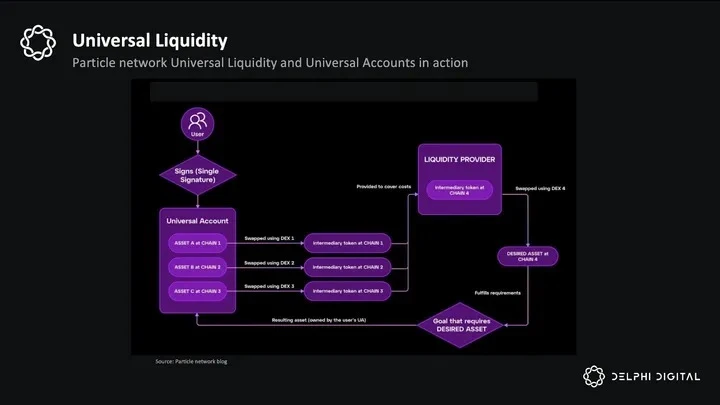
Universal Liquidity: Bundler nodes execute operations required for user transactions on any chain, such as token swaps and interactions with liquidity providers. This allows users to leverage their token balances across multiple chains, making it easy to interact with new chains without directly holding tokens on them. Operations created by users can interact with multiple chains using a single signature, managed by Universal Accounts and Bundlers for transaction construction, signing, and routing.
Universal Gas: When users initiate transactions, they are prompted to select their preferred gas token. This token is then managed by Particle's Paymaster contract, and gas payments are settled on the source and target chains. Some fees are converted to Particle's native $PARTI token on Particle L1.
These three solutions collectively provide a powerful abstraction experience for developers and end-users. Users can create cross-chain transactions without managing accounts or destination fuel, all in pursuit of a seamless end-user experience.
NEAR
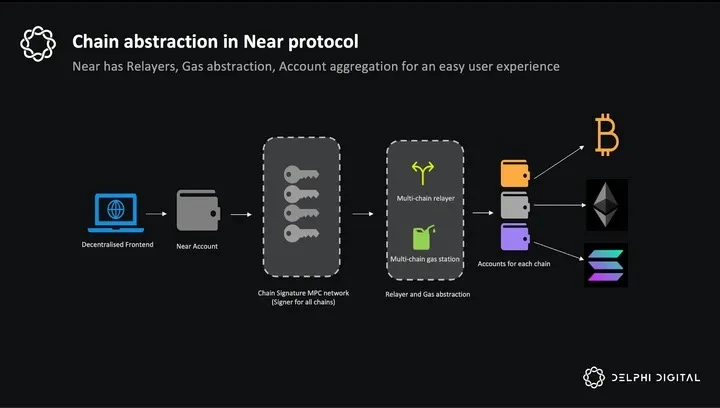
NEAR aims to provide a bridgeless cross-chain experience, unlike other protocols that rely on bridges. It achieves this through chain signatures, multi-chain relayers and multi-chain gas stations, and a decentralized frontend.
Account aggregation allows users to sign transactions on any blockchain using a single account, simplifying the user experience. NEAR has developed an MPC protocol called Chain Signatures using NEAR and Eigenlayer validators. The protocol generates and manages accounts on external chains without the need for additional keys or addresses. These accounts are derived from existing NEAR accounts. The workings of this will be explored in more detail in the "Unified Account Management" section.
Similar to the Particle Network, multi-chain gas stations and multi-chain relayers simplify the user experience by abstracting gas on external chains. As a result, users only interact with the DApp frontend, while orchestration, signing, gas payment, and relaying occur in the background.
A key feature of the NEAR approach is the ability to transfer asset ownership between different chains without actually moving the assets. This process starts with creating accounts on other chains using the MPC network, which are linked to the user's NEAR account. The ownership keys of these accounts are not wrapped or transferred assets but are transformed into NFTs on NEAR. Users can then trade these NFTs on NEAR, effectively transferring ownership of the assets without moving them.
This approach allows for high-throughput trading of native assets on NEAR, as only control keys are exchanged, not the assets themselves.
Neutron
Neutron is built using CosmosSDK and focuses on seamless cross-chain transactions using several key components. Inter-Chain Accounts (ICA) manage accounts on remote Cosmos chains, allowing them to hold assets and execute transactions. The Packet Forwarding Middleware (PFM) forwards IBC packets between chains, making cross-chain communication easier. IBC Hooks allow smart contracts to execute custom logic upon receiving IBC packets.
If a user wants to create cross-chain transactions using Neutron, the Inter-Chain Transaction (ICTX) module acts as the central orchestrator. Smart contracts on Neutron send requests to the ICTX module, specifying the target chain, inter-chain account, and operation to be executed. ICTX then creates an IBC packet containing transaction details and sends it to the target chain via a relayer. The remote chain processes the transaction and sends back a confirmation. This method of sending function calls through bridging is similar to Connext and ZetaChain.
Comparison with ZetaChain
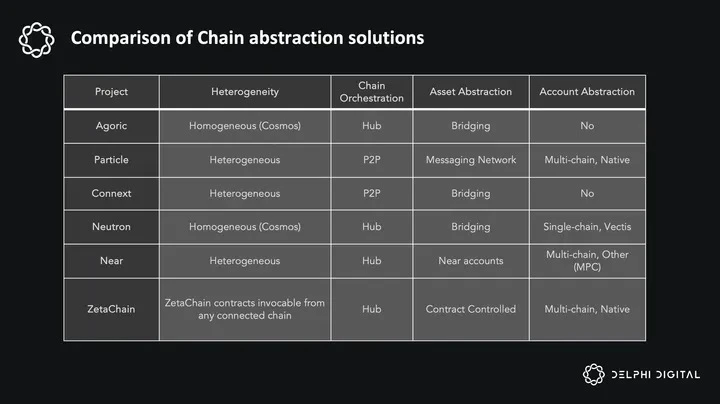
In most methods, cross-chain orchestration involves a bridge that transfers assets along with corresponding function calls and parameters. These assets and instructions are unwrapped on the target chain and executed by contracts. ZetaChain 2.0 also employs this method, with TSS signers and observers relaying data to ensure the security and accuracy of transactions.
ZetaChain allows DApp developers to create smart contracts that can control assets across multiple blockchains using TSS. This enables TSS to be programmable through the logic of the DApp. Developers can define complex rules for cross-chain asset management and automate multi-chain transactions. This approach opens up new applications and protocols.
ZetaChain also allows developers to build unified state and logic on a single chain, improving cross-chain applications. This approach is fundamentally different from traditional bridging solutions, which decentralize operations across multiple chains.
With ZetaChain, applications maintain their entire state and logic in one place, achieving synchronization and atomic execution. This is a significant improvement compared to point-to-point communication systems in bridges, which rely on asynchronous event-driven processes with fragmented states.
The benefits of this unified approach are substantial. It reduces the complexity of cross-chain applications. For example, implementing an AMM like Curve becomes straightforward. Developers can write a single smart contract that handles all logic in one place, instead of coordinating complex operations across multiple chains. Another key advantage is reliability. In fragmented systems, each step of a cross-chain transaction introduces a new potential point of failure. This can lead to partially completed transactions and funds being stuck. ZetaChain eliminates these risks. Transactions either fully complete or fully fail, with funds reverting to their original state.
This is because if a transaction needs to be rolled back, it can typically be done quickly and simply within the main chain, as most of the state and logic is contained in one place. If an external call is complex and fails, it provides an asynchronous rollback method for the application. This is particularly important for operations with specific conditions, such as swaps with slippage tolerance. In ZetaChain, if the slippage tolerance is not met, the entire transaction will roll back if a rollback function is provided. This can protect users from unexpected losses due to market conditions changing during execution.
Unified Account Management
Block space used to be scarce, but now it has become rich due to alternating L1s, aggregations on Ethereum, and application-specific chains. Applications are now distributed across these layers, providing many choices for users. There are account management solutions such as Magicspend and Keystore rollups that directly address these issues. After a deep dive into these issues, it is necessary to write a report on our own. Therefore, we will focus on how unified solutions like Near, Particle, and ZetaChain address these issues and their differences.
Particle Network
Particle Network has developed BTC Connect, extending the benefits of account abstraction to Bitcoin users. While direct account abstraction has not been implemented on Bitcoin L1, it is achieved through L2. These Bitcoin L2s integrate Particle's AA infrastructure components, such as bundlers and paymasters, allowing users to enjoy benefits like gasless transactions, account recovery, and key management.
BTC Connect has integrated with various Bitcoin wallet providers, including UniSat, OKX, and Bitget. When users interact with applications, they can connect to BTC Connect through their wallets. This connection automatically creates a smart account for users on Bitcoin L2. Users can then choose to interact with DApps through Bitcoin L1 or bridge their BTC to L2 to leverage the advantages of AA wallets. The entire process is seamlessly abstracted by BTC Connect, providing a smooth and user-friendly experience.
Near
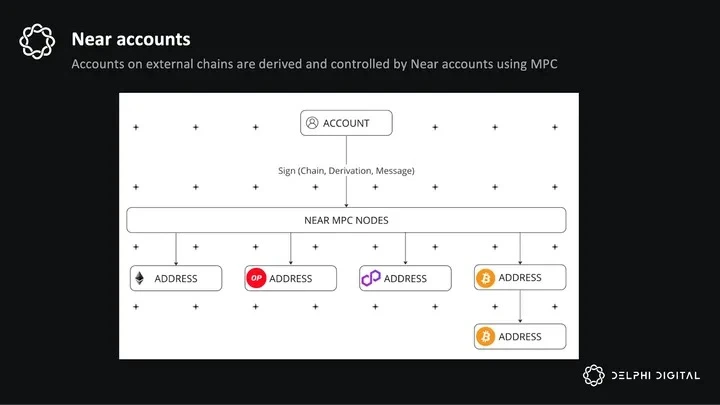
NEAR supports transaction signing across any blockchain using a single account. NEAR's account model integrates account abstraction. Users also benefit from human-readable accounts, with each application having different keys and specific access levels. NEAR extends this model by supporting multi-chain interactions through chain signatures, allowing NEAR accounts to create and manage remote accounts on other chains without users having to manage them separately.
This process uses a TSS protocol run by NEAR validators. This innovative TSS protocol allows validators to join and leave the network without changing public keys or key shares, making TSS a stable and reliable signer without the need for frequent adjustments.
Users can create new accounts on each chain, with the TSS network acting as signers, without users needing to maintain the private keys of these accounts. The TSS network can derive multiple accounts for the same chain using different paths through NearID, further enhancing security and usability. The ultimate experience for users is a single NEAR account connecting all chains, leveraging the benefits of TSS for signing and account abstraction.
A key difference in account management is the approach taken by NEAR compared to ZetaChain. NEAR heavily relies on its own network for interactions. When users want to create accounts or sign transactions for other chains, their NEAR account serves as the starting point for all interactions. Accounts on other chains are derived from the Near account and managed by the MPC network. In contrast, ZetaChain allows users to maintain their existing accounts on other chains and retain full custody. Users can initiate interactions from any source chain without needing a ZetaChain account to use full-chain applications developed and deployed on ZetaChain. This approach minimizes the need for users to create new accounts, as they can simply use existing accounts on other chains. Importantly, users maintain full custody by holding their private keys.
These two approaches make different trade-offs. NEAR's approach locks in users and serves as the entry point for all chain interactions, simplifying account management to some extent. On the other hand, ZetaChain provides users with more control and flexibility, allowing interactions from any chain. Ultimately, it may come down to what users prefer: NEAR's all-in-one package or ZetaChain's flexible self-contained account approach.
Bitcoin Restaking
Bitcoin is the largest and most secure digital asset, primarily due to its PoW mechanism. However, its limited programmability restricts its use for fundamental transactions. Previously, we discussed how ZetaChain's infrastructure supports restaking and full-chain staking, including for Bitcoin. Additionally, ZetaChain supports other full-chain applications for Bitcoin assets, such as lending, native exchanges, and ordinal markets. Bitcoin used on ZetaChain can be used for any application that utilizes smart contracts.
Restaking provides an opportunity to use the security of BTC for other applications and PoS chains. Let's explore and compare some other methods to extend the security of BTC to enhance its utility in various applications. We will also compare ZetaChain as a platform with Bitcoin L2.
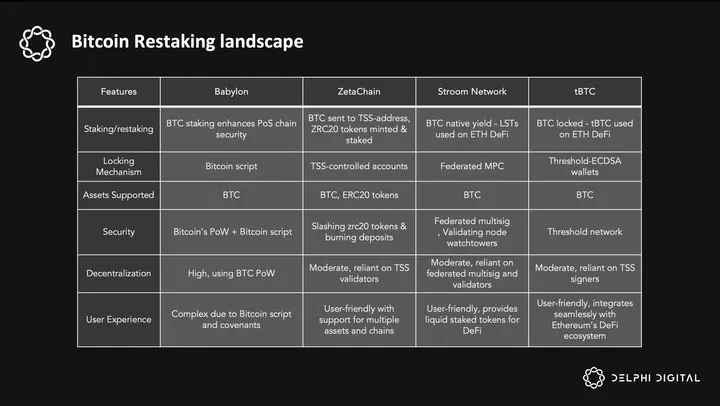
Babylon Chain
Babylon is a CometBFT chain based on Cosmos, which enhances the security of PoS chains by staking BTC. To stake BTC, it must be locked and controlled based on the behavior of validators. While Ethereum directly supports this, BTC does not. Typically, BTC is staked in multi-signature or threshold signature scheme (TSS) accounts. However, Babylon uses a trustless approach. It uses Bitcoin scripts to lock BTC for a period during which users can unlock and restake their BTC. This is accomplished using Extractable One-Time Signatures (EOTS).
Components:
Extractable One-Time Signatures (EOTS)
Covenants
Timestamps
Covenants: Covenants lock BTC in a vault until specific conditions are met, using Bitcoin script opcodes such as OP_CHECKTEMPLATEVERIFY (OP_CTV). Bitcoin's PoW security ensures the safety of BTC until these conditions are met.
EOTS: Validators use EOTS to sign blocks on the PoS chain. These signatures are used only once. If a validator signs two conflicting blocks at the same height, the EOTS reveals the validator's private key, allowing the protocol to slash the BTC. This punishes dishonest behavior and encourages honest validation.
Timestamps: Timestamps create an immutable record of data or transactions, preventing remote attacks on the PoS chain. This process synchronizes Bitcoin and the PoS chain, ensuring data integrity and expediting the unstaking of staked BTC. Timestamps reduce the unstaking time, allowing users to quickly retrieve their assets while preventing remote attacks.
Using these components, Babylon provides a trustless restaking alternative.
Stroom Network
Stroom Network allows users to stake their BTC and earn native BTC rewards without locking their funds. Users can also receive liquidity staking tokens, which can be used in DeFi protocols on Ethereum to increase earnings. The core idea is to provide liquidity using BTC in the Lightning Network, generating fees shared among users, DAOs, and node operators.
Stroom Bridge: This bridge connects Bitcoin to EVM-based blockchains. Users deposit BTC into the Stroom DAO treasury and receive stBTC or bstBTC on Ethereum. These wrapped tokens can be used in DeFi protocols on Ethereum, allowing users to earn additional rewards.
Stroom-Enabled Lightning Network Nodes: These nodes manage Lightning Network channels using users' BTC deposits. Nodes cannot directly access BTC; any changes to channel states require approval from validating nodes. Channel management is secured by jointly controlled multi-signature setups and Schnorr signature protection. Validating nodes also act as watchtowers, overseeing Lightning node activity.
Stroom Validating Nodes: These nodes approve operations using the FROST algorithm with Schnorr threshold signatures and maintain protocol security. They independently verify events, ensuring decentralization and security. They store channel states and revocation keys, updating LN state signatures as needed. As watchtowers managed by the DAO, they monitor Lightning Network channels through an integrated Bitcoin full node.
tBTC
tBTC is a decentralized bridge that allows BTC to be used on Ethereum. It enables users to mint tBTC, an ERC-20 token, by locking BTC in accounts controlled by the Threshold Network. This token can then be used in the DeFi ecosystem on Ethereum, providing more utility for Bitcoin holders.
The bridge randomly selects its operators for each epoch to ensure security. To secure Bitcoin deposits, tBTC requires the consent of a majority of operators, typically 51 out of 100 threshold wallets supported by ECDSA. This replaces centralized intermediaries with a decentralized cryptographic system.
To deposit BTC, users send it to one of these wallets using a Pay-to-Script-Hash (P2SH) or Pay-to-Witness-Script-Hash (P2WSH). The transaction includes the user's Ethereum address. Operators verify the transaction and mint tBTC on Ethereum, converting the BTC into a token compatible with Ethereum.
To redeem tBTC for BTC, users need to provide a Bitcoin address. The system reduces their tBTC balance and releases an equivalent amount of BTC to the provided address.
Products built on top of the tBTC bridge include:
Mezo: Mezo creates an economic layer using tBTC. It is a PoS network secured by staking Mezo and tBTC, allowing access to BTC DeFi and other utilities.
Acre: Acre offers a simple staking process for BTC input and output. Users deposit BTC and receive stBTC, representing partial ownership of BTC in the Acre treasury. This allows users to earn rewards from their BTC while maintaining stBTC liquidity. Acre stakes BTC in various L2s for economic security, rewarding validators with L2 tokens or BTC. Users can redeem their stBTC on Acre to claim rewards or convert back to BTC.
While these methods allow for restaking, they are specifically designed for this purpose. ZetaChain, on the other hand, allows restaking to be combined with other applications such as lending, exchanges, etc., to improve capital efficiency and be conducted in a single synchronous environment. Applications can also access user bases from other applications in the ecosystem.
Comparison with Other Bitcoin L2s
Bitcoin L2 enhances the utility of BTC through its MPC-based bridging and wrapped assets. However, ZetaChain uses TSS-controlled addresses on the Bitcoin network to represent its ZRC-20 tokens on-chain. Compared to Bitcoin sidechains based on MPC, TSS can be more decentralized, as larger, more distributed TSS sets provide greater Byzantine fault tolerance.
Additionally, ZetaChain's TSS supports full-chain applications, allowing them to interact with contracts on other chains. This means BTC applications on ZetaChain can seamlessly interact with multiple contracts on different chains. In contrast, BTC L2 only offers composability within its own platform.
While bridges based on BitVM and CatVM can provide trustless or trust-minimized alternatives, they are not yet practical.
Future Outlook for UX and ZetaChain's Role
The future of blockchain user experience will see significant improvements driven by infrastructure like ZetaChain. Here are the expectations and roles ZetaChain can play:
Seamless Interactions: The trend is moving towards seamless and intuitive user interactions where underlying technology becomes invisible to end users. ZetaChain's chain abstraction approach is a significant step in this direction, making blockchain interactions as simple as using any Web2 application.
Unified User Interface: With the ability to handle cross-chain interactions natively, applications can provide a unified interface where users can manage assets, execute transactions, and interact with multiple chains from a single platform. This will greatly enhance the overall user experience.
Enhanced Application Ecosystem: As ZetaChain achieves more complex cross-chain functionalities, we can expect the development of richer and more sophisticated application ecosystems. These ecosystems will provide more integrated and interoperable services, offering users a comprehensive set of tools and functionalities.
Mainstream Adoption: Simplifying user experience is key to driving mainstream adoption of blockchain technology. By eliminating barriers associated with complexity and usability, ZetaChain can play a crucial role in bringing blockchain to a wider audience of non-technical users.
Innovative Use Cases: The ability to execute complex operations across multiple blockchains will lead to the emergence of new and innovative use cases. Developers will have the tools to create applications that were previously not possible, driving further innovation in the field.
免责声明:本文章仅代表作者个人观点,不代表本平台的立场和观点。本文章仅供信息分享,不构成对任何人的任何投资建议。用户与作者之间的任何争议,与本平台无关。如网页中刊载的文章或图片涉及侵权,请提供相关的权利证明和身份证明发送邮件到support@aicoin.com,本平台相关工作人员将会进行核查。




